
Georg von Rauch Haus (named after Georg von Rauch) is a squat in Kreuzberg, Berlin, established in 1971. It became an important center for the city's left-wing/countercultural milieu in the early 1970s.

Georg von Rauch Haus (named after Georg von Rauch) is a squat in Kreuzberg, Berlin, established in 1971. It became an important center for the city's left-wing/countercultural milieu in the early 1970s.
The Georg von Rauch Haus was built as part of the Bethanien hospital at Mariannenplatz in Kreuzberg, Berlin. It was formerly a residence for nuns called the Martha Maria Haus, which was left derelict in 1970. [1]
On December 8, 1971, a teach-in was organised at the Technische Universität Berlin to commemorate the death of activist Georg von Rauch. Following a concert by Ton Steine Scherben, the building was squatted by 300 people and named after von Rauch. [1] It was one of the first squats in West Berlin. [2] The squatters were young homeless people, students and workers. [3] [1]
The occupation was legalized by the local authorities and inspired Ton Steine Scherben's "Rauch-Haus-Song". [1] [4] It became an important center for the city's left-wing/countercultural milieu and was raided in 1972 by the police looking for Bommi Baumann. [3]

Ralph Christian Möbius, known professionally as Rio Reiser, was a German musician and from 1970 to 1985 the lead singer and main lyric-writer for the rock group Ton Steine Scherben. After that band broke up, he worked as a solo artist. Among his best known songs are Macht kaputt, was euch kaputt macht, Keine Macht für Niemand, and the Rauch-Haus-Song with the Ton Steine Scherben. As a solo artist, his best known songs are König von Deutschland, Alles Lüge, and Junimond. Reiser supported squatting in the early 1970s and later the green political party Die Grünen. After the German reunification, he joined the Party of Democratic Socialism.

Ton Steine Scherben was one of the first and most influential German language rock bands of the 1970s and early 1980s. Well known for the highly political and emotional lyrics of vocalist Rio Reiser, they became a musical mouthpiece of new left movements, such as the squatting movement, during that time in Germany and their hometown of West Berlin in particular. Today, after the band's demise in 1985, and the death of Rio Reiser in 1996, Ton Steine Scherben have retained a cult following and popularity in the related scenes. Recently, some of the remaining members have given reunion concerts.
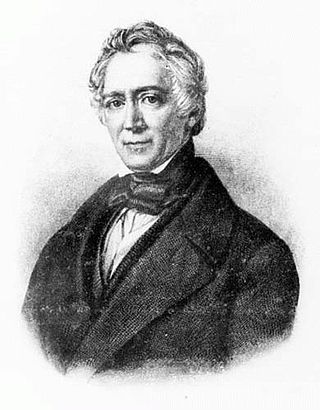
Friedrich Ludwig Georg von Raumer was a German historian. He was the first scientific historian to popularise history in German. He travelled extensively and served in German legislative bodies.
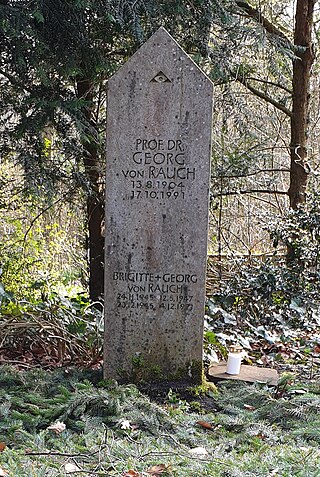
Georg von Rauch was a member of the 1960s-70s German student movement.
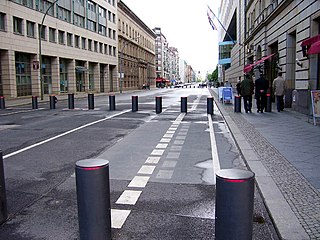
Wilhelmstrasse is a major thoroughfare in the central Mitte and Kreuzberg districts of Berlin, Germany. Until 1945, it was recognised as the centre of the government, first of the Kingdom of Prussia, later of the unified German Reich, housing in particular the Reich Chancellery and the Foreign Office. The street's name was thus also frequently used as a metonym for overall German governmental administration: much as the term "Whitehall" is often used to signify the British governmental administration as a whole. In English, "the Wilhelmstrasse" usually referred to the German Foreign Office.
Thomas Weissbecker, known as Tommy (1949–1972), was a German leftwing militant shot dead by police at the age of 23. He was involved with the Haschrebellen, the Tupamaros West-Berlin, the 2 June Movement and the Red Army Faction. After his death, the Tommy Weisbecker Haus was squatted in Berlin.
This following is a list of the work released by German rock band Ton Steine Scherben. It is currently missing the (few) singles issued by the band.
Michael "Bommi" Baumann was a German author and former militant. After growing up in Berlin, he was radicalised by the police shooting of Benno Ohnesorg and founded the Movement 2 June with his best friend Georg von Rauch. After von Rauch was shot dead by the police and a bomb planted by Baumann killed a builder, Baumann fled abroad. Whilst on the run he wrote the memoir Wie alles anfing and renounced political violence. The book sold 100,000 copies. Baumann was arrested in London in 1981 and following a prison term lived in Berlin.

The "Rauch-Haus-Song" is a track performed by West Berlin band Ton Steine Scherben on their second studio album Keine Macht für Niemand. It has become famous in leftwing circles in Germany.

Warum geht es mir so dreckig? is the first album released by the German rock band Ton Steine Scherben. It includes—among other pieces—the song Macht kaputt, was euch kaputt macht, which expressed the built-up anger and radicalization of the youth of the late 1960s and early 1970s.

Keine Macht für Niemand is the name of both the second album and best-known song by the German rock band Ton Steine Scherben. The double album, released in 1972, is also sometimes called “die Weiße” in reference to its simple cover with a white background and black text.

The Dorotheenstadt Cemetery, officially the Cemetery of the Dorotheenstadt and Friedrichswerder Parishes, is a landmarked Protestant burial ground located in the Berlin district of Mitte which dates to the late 18th century. The entrance to the 1.7-hectare (4.2-acre) plot is at 126 Chaussee Straße. It is also directly adjacent to the French cemetery, established in 1780, and is sometimes confused with it.
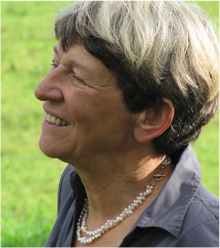
Cristina Perincioli is a Swiss film director, writer, multimedia producer and webauthor. She moved to Berlin in 1968. Since 2003 she lives in Brandenburg.

The Prussian National Monument for the Liberation Wars is a war memorial in Berlin, Germany, dedicated in 1821. Built by the Prussian king during the sectionalism before the Unification of Germany it is the principal German monument to the Prussian soldiers and other citizens who died in or else dedicated their health and wealth for the Liberation Wars (Befreiungskriege) fought at the end of the Wars of the Sixth and in that of the Seventh Coalition against France in the course of the Napoleonic Wars. Frederick William III of Prussia initiated its construction and commissioned the Prussian Karl Friedrich Schinkel who made it an important piece of art in cast iron, his last piece of Romantic Neo-Gothic architecture and an expression of the post-Napoleonic poverty and material sobriety in the liberated countries.
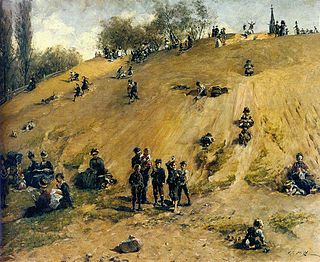
The Kreuzberg is a hill in the Kreuzberg locality of Berlin, Germany, in former West Berlin. It rises about 66 m (217 ft) above the sea level. It was named by King Frederick William III of Prussia after the Iron Cross which crowns the top of the Prussian National Monument for the Liberation Wars, designed by Karl Friedrich Schinkel, on its inauguration on 30 March 1821. On 27 September 1921 the borough assembly of the VIth borough of Berlin decided to name the borough after the hill. The borough was subsequently downgraded to a locality in 2001.
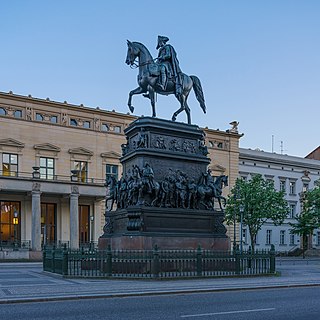
The equestrian statue of Frederick the Great on Unter den Linden avenue in Berlin's Mitte district commemorates King Frederick II of Prussia. Created from 1839 to 1851 by Christian Daniel Rauch, it is a masterpiece of the Berlin school of sculpture, marking the transition from neoclassicism to realism. The bronze statue shows "The Old Fritz" dressed in military uniform, ermine coat and tricorne hat on horseback above the leading generals, statesmen, artists and scientist of his time. Walled in during World War II, it was disassembled by East Germany in 1950, reassembled in Sanssouci Park in 1963, and returned to its original location in 1980.
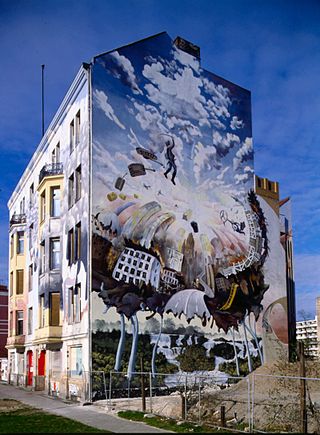
The Tommy Weisbecker Haus is a housing co-operative and self-managed social centre based in an apartment block in Kreuzberg, Berlin, Germany. It was established in 1973 when young people squatted it as an autonomous youth homeless shelter. Quickly legalized, it became a housing project and signed a new 30-year lease in 2013.
"Macht kaputt, was euch kaputt macht" is a 1970 song by German proto-punk band Ton Steine Scherben and a subsequent political slogan. Written in 1969, it first appeared as a single the next year, followed by the band's 1971 debut album Warum geht es mir so dreckig? The slogan was subsequently used in the German autonomous, squatting, and contemporary anarchist outgrowths of the 1960s West German student movement.
The modern political squatting movement began in Hamburg, Germany, when Neue Große Bergstraße 226 was occupied in 1970. Squatters wanted to provide housing for themselves amongst other demands such as preventing buildings from being demolished and finding space for cultural activities. The Hafenstraße buildings were first occupied in 1981 and were finally legalized after a long political struggle in 1995. The still extant Rote Flora self-managed social centre was occupied in 1989. Squatting actions continue into the present; more recent attempts are quickly evicted, although the Gängeviertel buildings were squatted and legalized in the 2010s.
Britta is an indie rock band, founded in the beginning of 1997 in Berlin, Germany. The band produced four albums, which were all released on the indie label Flittchen Records.